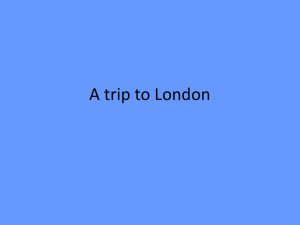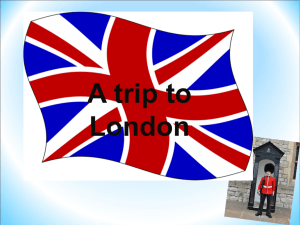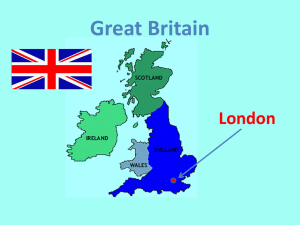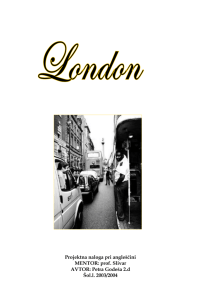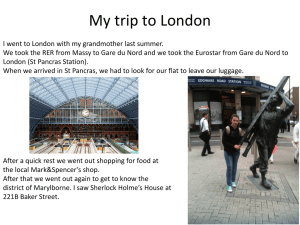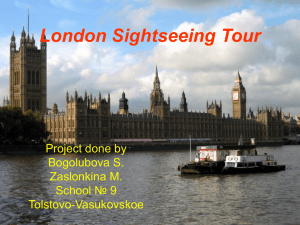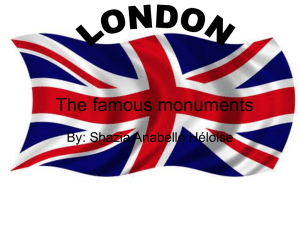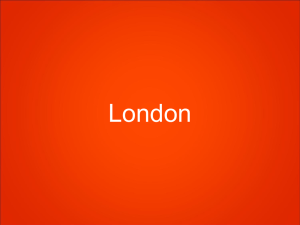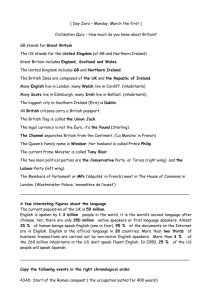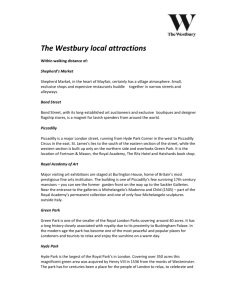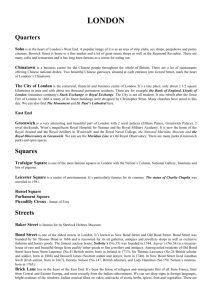2. London - Uč se online!
advertisement
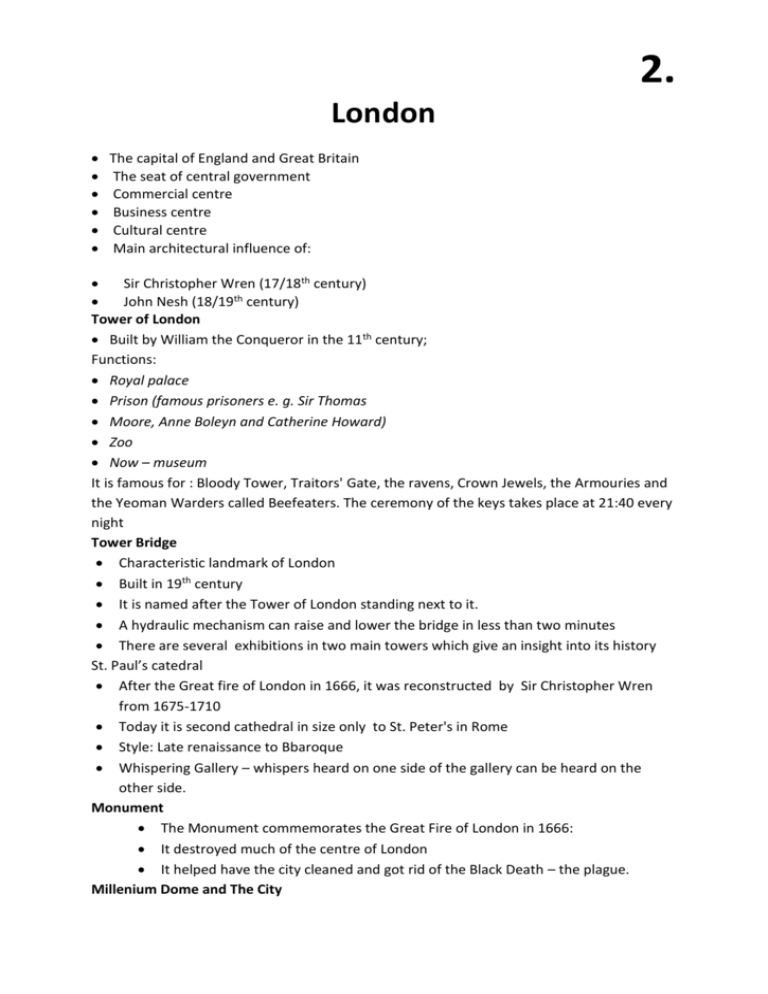
2. London The capital of England and Great Britain The seat of central government Commercial centre Business centre Cultural centre Main architectural influence of: Sir Christopher Wren (17/18th century) John Nesh (18/19th century) Tower of London Built by William the Conqueror in the 11th century; Functions: Royal palace Prison (famous prisoners e. g. Sir Thomas Moore, Anne Boleyn and Catherine Howard) Zoo Now – museum It is famous for : Bloody Tower, Traitors' Gate, the ravens, Crown Jewels, the Armouries and the Yeoman Warders called Beefeaters. The ceremony of the keys takes place at 21:40 every night Tower Bridge Characteristic landmark of London Built in 19th century It is named after the Tower of London standing next to it. A hydraulic mechanism can raise and lower the bridge in less than two minutes There are several exhibitions in two main towers which give an insight into its history St. Paul’s catedral After the Great fire of London in 1666, it was reconstructed by Sir Christopher Wren from 1675-1710 Today it is second cathedral in size only to St. Peter's in Rome Style: Late renaissance to Bbaroque Whispering Gallery – whispers heard on one side of the gallery can be heard on the other side. Monument The Monument commemorates the Great Fire of London in 1666: It destroyed much of the centre of London It helped have the city cleaned and got rid of the Black Death – the plague. Millenium Dome and The City 2. Millennium Dome (O2) Is an exhibition hall built on the Meridian Line in Greenwich to celebrate the start of the new Millennium. The City Today, this area is the financial centre of Europe. It has only 6000 residents and is almost deserted during the weekend. Skyscrapers: Natwest Tower; The Lloyd‘s of London, designed by Richard Rogers, the architect of the Centre Pompidou in Paris; New office building City Point; Swiss Re building – modern glass tower, designed by Fosters and Partners; Barbican Centre – a urban complex is a city inside city. The London Stock Exchange (LSE), founded in 1801, one of the largest stock exchanges in the world. The former Stock Exchange Tower, based in Threadneedle street was opened by the Queen Elizabeth II in 1972. In July 2004 the LSE moved to Paternoster Square close to St Paul‘s Cathedral, still within the „Square Mile“ (the City of London). It was officially opened by Queen Elizabeth II once again. The City of Westminister The Houses of Parliament On the left bank of the Thames Rebuilt in Gothic style (1840-1857) on the site of the old Palace of Westminster, which was destroyed by fire in 1834. Visitors can go to both the House of Lords and the House of Commons. The Clock Tower Big Ben is the bell of the clock tower of the Houses of Parliament. It was made in 1858. Called after Sir Benjamin (Ben) Hall, one of the ministers, who was tall and stout. London Eye The British Airways London Eye (Ferris Wheel) is the world‘s tallest observation wheel at 135 m high. It is located on the bank of the river Thames and it is major landmark and tourist attraction. It offers marvellous view over London It was opened by British Prime Minister Tony Blair on December 31,1999, although it was not opened to the public until March 2000. Buckingham Palace Is the London home of the Queen. Queen Victoria was the first monarch in Buckingham Palace, and it has served as the official London residence of Britain‘s sovereigns since 1837. Originally known as Buckingham House built for the Duke of Buckingham. It was enlarged principally by architects John Nash and Edward Blore. It is in style of Neoclassical architecture. 2. When Her Majesty is in residence, the Royal Standard is flown from the flagstaff. Since 1993 parts of the Palace have been opened to the public. The changing of the guard at Buckingham Palace is popular event. Downing street No. 10, Downing Street, has been the official residence of the Prime Minister since 1715. Downing Street gates were erected at each end of Downing Street to protect the PM (then M. Thatcher) from terrorist attacks, particularly from the Provisional IRA. Piccadilly Circus Created by John Nash The creation of the Shaftesbury Avenue in 1885 turned the plaza into a busy traffic junction. This attracted the first illuminated advertisements in London in 1895 Now it is partly pedestrianised and within walking distance to Trafalgar Square, Soho, Chinatown, Shaftesbury Av. New Scotland Yard The headquarters of the Metropolitan Police. It works app. from 1829 to the present The Old Royal Observatory From where Greenwich Mean Time is taken, stands in Greenwich Park overlooking the river Thames. You can stand with one foot in the East and one in the west astride the Greenwich Meridian and set your watch every day at 1p.m. precisely by the falling time-ball. The Royal Albert Hall Dedicated to Queen‘s Victoria‘s husband and consort (choť) Prince Albert. Each year it hosts more than 350 performance including classical concerts, rock and pop, ballet and opera, tennis, award ceremonies act. Madame Tussaud‘s A wax museum Favourite tourist attraction Opened first permanent exhibition in 1835 Globe Theatre Original one, built in 1599 by the playing company to which Shakespeare belonged (destroyed by fire in 1613) A modern reconstruction of the original Globe now „Shakespeare‘s Globe Theatre“, opened in 1997. Royal National Theatre Placed on the South bank of the Thames Royal Opera House, Covent Gardens Covent Garden is known for its many open-air cafés, pubs, market stalls and shops. A former floral market now houses the Theatre Museum and the London Transport 2. Museum. The Covent Garden district is also home to the recently renovated Royal Opera House. Museum and Galeries The Natural History Museum, the Science Museum, the National Gallery, the Tate Gallery, the British Museum British Museum – houses archaeological and ethnographical collections National Gallery – the collection of Western painting from the 13th-20th century Tate Gallery – the national collection of British painting and 20th century painting and sculpture . The Sherlock Holmes Museum (at 221b Baker Street. Hyde Park One of the several royal parks connected to each other, forming one large green lung in the centre of the city. It is popular place for jogging, swimming, rowing, picnicking and horse riding. In the 19th century it became a popular place for meetings. In 1872, in response to riots after police tried to disband a political meeting, Speaker‘s Corner was established to create a venue where people would be allowed to speak freely. Here, every Sunday people stand on a soap box and proclaim their views on whichever event they want. Marble Arch – just outside Hyde Park. It was originally built in 1872 as a gateway to Buckingham Palace, but it was too narrow. The design by John Nash was based on the Arch of Constantine in Rome. The other parks are the neighbouring Kensington Gardens, Green Park and St. James‘s Park. London Transport Underground, called Tube. Parts of the systemem are very old, the first line opened in 1863. Taxis are a very popular means of transport in London and so are red doubledecker buses. Main three airports: Heathrow, Gatwick and Stansted. Shopping Oxford Street – fashionable clothes, department stores (Marks and Spenser, John Lewis. Regent street Bond Street Covent Garden

